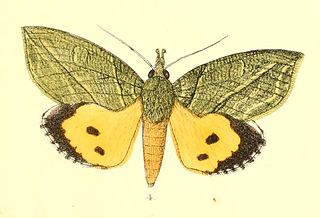
Eudocima hypermnestra is a moth of the family Erebidae described by Pieter Cramer in 1780. It is found in China, Thailand, Taiwan, India and Sri Lanka.

Chiasmia emersaria is a moth of the family Geometridae. The species was first described by Francis Walker in 1861. It is found in India, Nepal, northern Thailand, China, Sri Lanka, Japan and the Ryukyu Islands.

Hyperythra lutea is a moth in the family Geometridae. The species was first described by Caspar Stoll in 1781. It is found in Indian subregion, Sri Lanka, South East Asia, Sundaland.
Chrysendeton azadasalis is a moth in the family Crambidae. It was described by William Schaus in 1924. It is found in Guyana.
Dodanga cristata is a moth in the family Crambidae. It was described by George Hampson in 1891. It is found in India and Sri Lanka.
Scoparia atricuprea is a moth in the family Crambidae. It was described by George Hampson in 1917. It is found in South America and on the Antilles.
Blepharomastix beuvealis is a species of moth in the family Crambidae. It was described by William Schaus in 1924. It is found in French Guiana.
Polygrammodes dubialis is a moth in the family Crambidae. It was described by Schaus in 1924. It is found in Brazil.
Salbia ecphaea is a moth in the family Crambidae. It was described by George Hampson in 1912. It is found in Colombia.
Salbia pachyceralis is a moth in the family Crambidae. It was described by George Hampson in 1917. It is found in Panama.
Sameodes microspilalis is a moth in the family Crambidae. It is found in Zimbabwe.
Sufetula macropalpia is a moth in the family Crambidae. It was described by George Hampson in 1899. It is found in Indonesia.
Syllepte leucographalis is a moth in the family Crambidae. It was described by George Hampson in 1912. It is found in Indonesia (Bali).
Syllepte methyalinalis is a moth in the family Crambidae. It was described by George Hampson in 1912. It is found in Guyana.
Syllepte rogationis is a moth in the family Crambidae. It was described by George Hampson in 1918. It is found in Mozambique.
Syngamia albiceps is a moth in the family Crambidae. It was described by George Hampson in 1912. It is found in Singapore.
Tylostega tylostegalis is a moth in the family Crambidae. It was described by George Hampson in 1900. It is found in the Russian Far East and western China.
Tyspanodes piuralis is a moth in the family Crambidae. It was described by Schaus in 1920. It is found in Peru.
Udea scoparialis is a moth in the family Crambidae. It was described by George Hampson in 1899. It is found in Tibet, China.
Ambia vagilinealis is a moth in the family Crambidae. It is found in Papua New Guinea.


